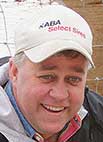Cutting and Quarter Horses
Joe and Karen Prock have tried many breeds of horses, and they can tell you their reasoning for their choices
Transfers for Breed Improvement
Marty and Cheryl Brown use embryo transfer to make their registered herd expansion a faster process
Expansion Is His Best Way
Freddie Martin has spent a lifetime watching the cycles of agriculture; and he's still growing his dairy herd today
All Angus, Always
A few are red, most are black, but they are all Angus at Wallace Cattle Company, where Ernie and Tammy Wallace may have compromised on color, but never on the quality of their registered herd.
Tammy loves the reds she grew up with in Iowa, where her parents were pioneer breeders and have been in the business more than 40 years. Ernie is partial to the blacks, a love he picked up while working as a young man on a purebred ranch in Texas. Together, the two have been raising registered Angus since they were married 18 years ago.
Tammy loves the reds she grew up with in Iowa, where her parents were pioneer breeders and have been in the business more than 40 years. Ernie is partial to the blacks, a love he picked up while working as a young man on a purebred ranch in Texas. Together, the two have been raising registered Angus since they were married 18 years ago.
Expansion and Quality
In the rugged terrain and the demanding brutal conditions of rural Scotland a particular breed of cattle has been able to thrive for centuries, the Scottish Highlander.
Highlanders began being imported into the United States during the mid to late 1800’s when a “herd book” or national registry was established in 1884 making them the oldest registered breed of cattle in the country.
Highlanders began being imported into the United States during the mid to late 1800’s when a “herd book” or national registry was established in 1884 making them the oldest registered breed of cattle in the country.
Predators, Parasites? No Problem
Brad and Joanna Carter’s registered Angus and Boer Goats may be a small-time operation, but that doesn’t stop them from taking specific steps towards improving their breeding programs.
“We AI our cattle, but we’re not brave enough to AI our goats,” Joanna laughed. The Carters have had goats for five years, and cattle for longer than that. When they moved to their current location, in Dadeville, Mo., Brad said their fields were covered with serecia lespedeza. “The cattle wouldn’t eat it, that and all our brush. So we got goats to take care of it,” he recalled.
“We AI our cattle, but we’re not brave enough to AI our goats,” Joanna laughed. The Carters have had goats for five years, and cattle for longer than that. When they moved to their current location, in Dadeville, Mo., Brad said their fields were covered with serecia lespedeza. “The cattle wouldn’t eat it, that and all our brush. So we got goats to take care of it,” he recalled.
Charolais with a Side of Angus
The greatest compliment a son can give his parents is to follow in their footsteps, especially regarding his choice of occupation. Mark Satterfield along with his wife, Nancy, must bring special warmth to the hearts of his parents, Loyd and Joanne.
Marketing at Every Stage
There is no shortage of Limousin cattle around Glen Parker’s neck of the woods.
Glen, who operates Piney Bay Limousin, said there are five breeders raising the cattle all within a 10-mile radius of his farm, located in London, Ark.
Glen, who operates Piney Bay Limousin, said there are five breeders raising the cattle all within a 10-mile radius of his farm, located in London, Ark.
Red River Roundup
From their home on the Bar of Ranch, to Buffalo Rock, a familiar landmark, the rolling pastureland owned by Dan and Peggy Eoff covers 600 acres. Two miles from Clinton, Ark., the ranch sits in a valley below Culpepper Mountain and is traversed by three miles of the South Fork of the Little Red River.
Being Aware of What Goes In
In the cattle business there are big rewards for finding a niche that develops into a national interest. Rodney Lowrance of Pleasant Hope, Mo. is taking his investment in Gelbvieh cattle and possibly venturing into one of these niches; grass-fed meat production.





